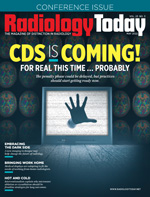 MRI Monitor: Hanging on a Heartbeat
MRI Monitor: Hanging on a Heartbeat
By Lisa Pritchard
Radiology Today
Vol. 23 No. 3 P. 8
Overcoming the Challenges of Interpreting Cardiac MRIs
Cardiologists and radiologists at hospitals and outpatient centers across the United States use MR cardiac functional analyses to evaluate the anatomy and functioning of their patients’ hearts. These are very detailed exams which require the use of complex software programs, such as Medis and Circle 42, and careful processing by specialist technologists. They also have a turnaround time of 12 to 24 hours in order to fully analyze and postprocess the images. As a result, many centers have been slow to embrace cardiac MRI.
However, these analyses can play a valuable role in investigating many conditions, ranging from a cardiac mass or thrombus to cardiomyopathy, arrhythmias, and congenital cardiac disease. While an echocardiogram is easier to perform, it is not as accurate as MRI. An MRI also has the advantage of being a noninvasive procedure, unlike a cardiac catheterization.
A cardiac MRI is the most accurate exam for assessing ejection fraction; it can measure the efficiency of the left and right ventricles, as well as the percentage of blood in the heart that is pumped out when it beats. A healthy left ventricle pumps about 65% of its blood with each beat, but that differs between men and women and there is a range of about 12%.
Contouring the Heart
To make the necessary measurements for an MR cardiac functional analysis, contours must be applied to the MRI exam, outlining specific structures in the heart. While the software programs can apply contours to the image based on average results, every heart is different, so the technologist must verify all aspects of the trace and manually adjust it as necessary to make a close fit. The technologist must draw contours around the endocardium—the inner lining of the chambers of the heart—and show the actual blood pooling within the ventricles. Then, they must contour the heart’s muscular layer—the myocardium—when the heart is at end-systolic (full contraction) and end-diastolic (full relaxation).
Once the heart is contoured in the end-systolic and end-diastolic phases, the software can calculate the systolic and diastolic volumes and the ejection fraction for both the left and right ventricles. It takes about 40 minutes to contour an entire heart, then the software creates a report for the referring physician that provides all of the values.
Assessing Specific Indications
Cardiomyopathy, a weakening of the heart muscle that results in a low ejection fraction, is a condition that is seen frequently. It is usually the result of a patient having had a myocardial infarction—a heart attack—which causes damage to the heart muscle and makes it harder for the heart to pump.
When a patient has a high ejection fraction, it is due to hypertrophic cardiomyopathy—a thickening of the heart muscle. The cause is often unknown. Delayed enhancement MRI sequences are used to quantify heart muscle damage. The patient is given an injection of contrast agent, and their imaging is delayed for 10 to 15 minutes. That delay gives the heart muscle time to take up the contrast agent and turn bright white, allowing tissue scarring to be quantified by the software.
Investigating Complex Pathologies
The most challenging MR cardiac exams result from the most complex pathologies. With congenital heart disease cases, for example, patients have usually had multiple surgeries, often as children. They may have Fontan shunts and, perhaps, a transposition of the aorta and pulmonary arteries. There are also cases where a patient’s right and left ventricle have fused, forming a single-ventricle heart. In those cases, it is challenging to place the contours that best represent the functioning of the heart. As existing software programs were developed based on typical anatomy, all of the contours must be hand-drawn for hearts with an atypical form.
Another technique, called 2D or 4D velocity encoding (VENC) flows, can be used to investigate heart valve disease. If a heart valve is not closing completely, blood shoots through but some washes back. A VENC flow can measure forward velocity and peak velocity gradients, such as the peak pressure gradient or the regurgitant fraction, and help explain why the heart is not pumping correctly.
A VENC flow exam requires watching the actual blood flow and contouring the valves multiple times, when open and closed, while the aorta is pumping. A series of 2D VENC flows is performed for each heart valve. Each series requires a breath hold by the patient in the MRI scanner. If the patient is unable to hold their breath, a 4D VENC flow exam, which shows the blood flowing through the entire heart and great vessels, can be conducted instead. A technologist can take 20 measurements in a sequence in the required locations and then determine the regurgitant values and the peak velocities. This more advanced 4D VENC flow exam is often used for patients with congenital heart disease.
Growing Demand
One reason for this uptick in cases during the past couple of years has been the COVID-19 pandemic. Patients in advanced stages of the disease have hyperinflammation throughout their body, including myocarditis, or inflammation of their heart muscle. Researchers began studying COVID patients’ MR cardiac exams, not only for function but also for strain in T1 and T2 images. The standard of care has also changed. COVID-19 patients are no longer being taken directly to the cardiac catheterization laboratory; they are having a CT and/or MRI first, and those exams are being covered by health care insurance and Medicare.
MR cardiac functional analyses represent a highly accurate, efficient approach to quantifying structural or functional issues with a patient’s heart. The resulting report helps ensure that the requesting physician is fully informed and can provide the most appropriate care.
— Lisa Pritchard is manager of the advanced specialty department at 3DR Labs, an Accumen company.

